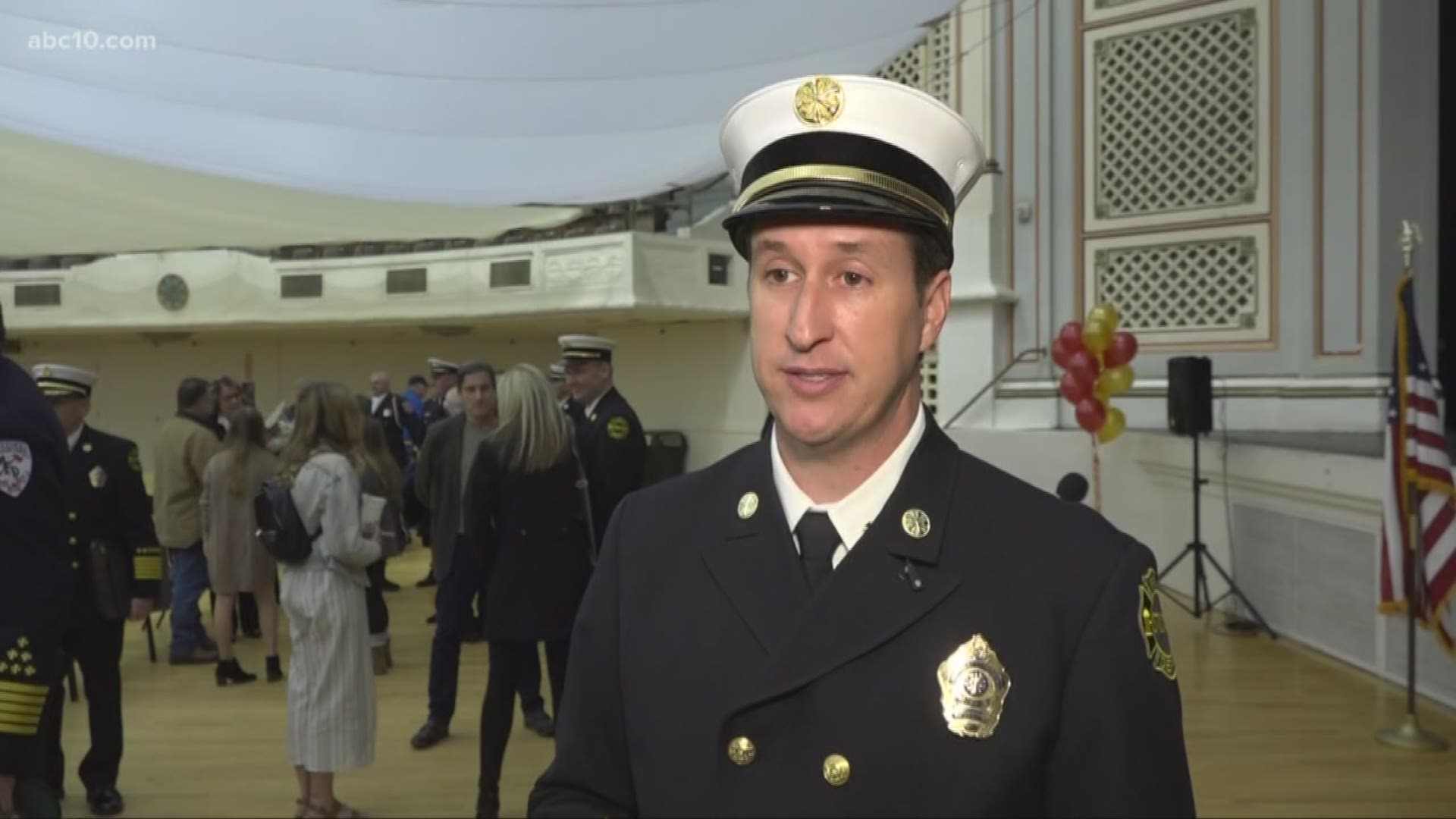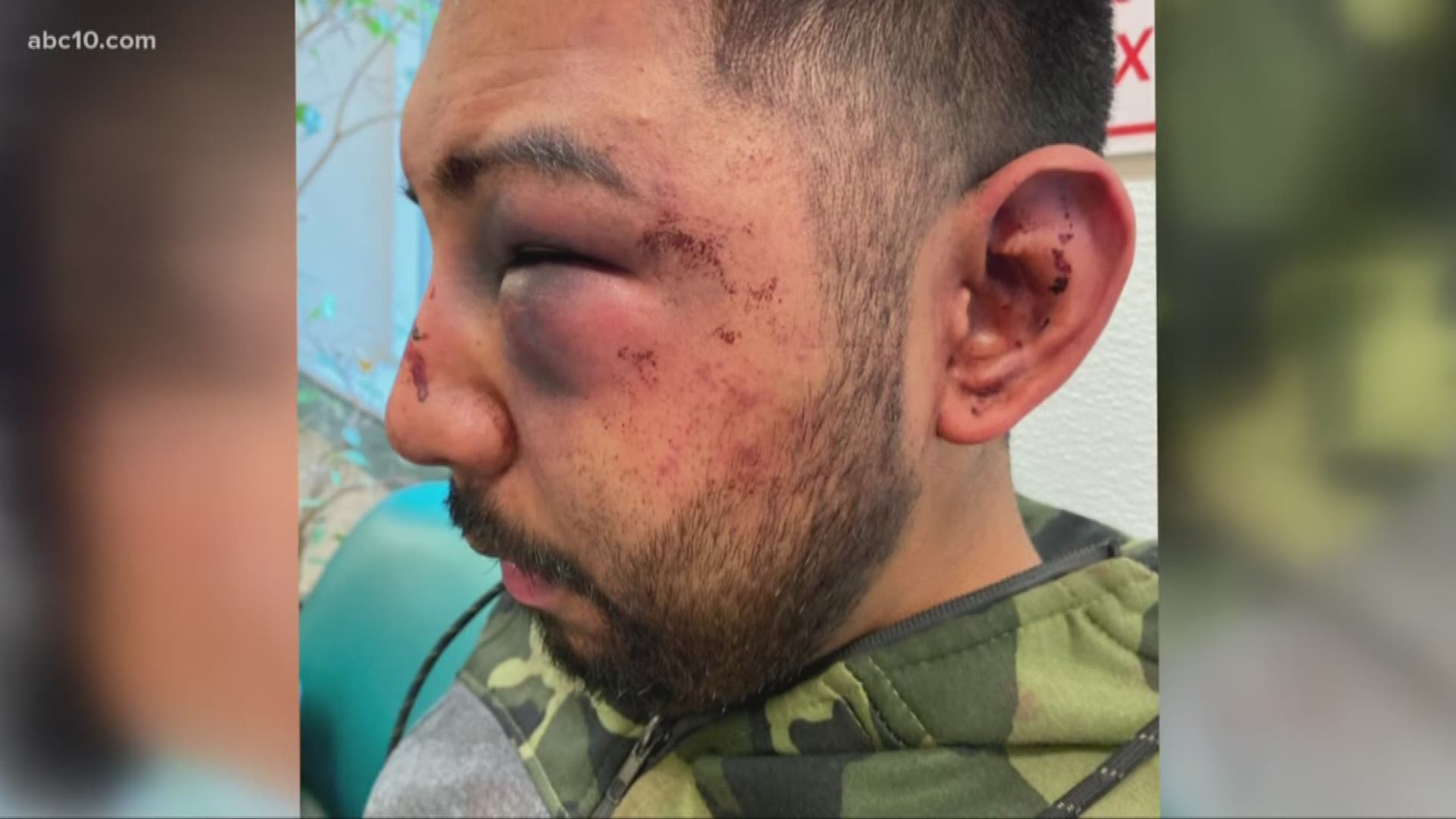STOCKTON, Calif. — On Friday, Dec. 13, Interim City Manager Laurie Montes announced that Deputy Fire Chief Richard Edwards would be appointed as Stockton's new Fire Chief, and on Jan. 1, Edwards officially began his appointment.
A nationwide search was conducted for the position after the retirement of Erik Newman earlier this year, only to lead right back to the Stockton Fire Department [SFD], where Edwards has been active for many years. Last week, a formal badge pinning ceremony was held after ringing in the New Year.
Edwards has a long history in fire protection and prevention. His service in the city of Stockton, for instance, is far from just beginning.
"Since 1995, I've worked in the fire service, so it's a long history," Edwards said in a conversation with ABC10. "[I] worked in other agencies, been fortunate to work here in the city of Stockton since 2000. I was hired as a firefighter paramedic here and promoted through every rank."
As a volunteer firefighter in the Diamond Springs El Dorado Fire Protection District in 1995, Edwards realized an interest in the fire protection field. Just two years later, he started working full-time as a firefighter paramedic for the Georgetown Fire Protection District.
His resume is stacked: he is a licensed Paramedic, Fire Officer, Emergency Management Specialist, and Chief Fire Officer. He holds an Associate’s degree in Business Administration from Sierra College in Rocklin, a Bachelor’s in Emergency Management from Waldorf University, Iowa, and is currently pursuing a Master’s degree from Waldorf in Organizational Leadership and Public Administration.
"Each of my different positions has given me a different insight into the fire service as a whole and allowed me to make and develop relationships with our internal and external partners — not just at the local level here in the city, but within the county, and also at the state level," Edwards said.
But Edwards isn't content to sit back and let his record speak for itself. Instead, he is intent on improving SFD and reigniting connections between fire safety officers and the greater population that they serve.
"I'm stepping into this position to help insure that the Stockton Fire Department can provide the absolute best level of service, within our means, to the community," Edwards said. "That includes doing everything we can to actively reduce emergencies through community risk reduction efforts, public education, and so forth. Then, when they do you have that emergency, that we're providing them with the absolute best level of service with some of the highest trained, most competent firefighters in the United States."
It's a tall order to fill, but if anyone has a good chance to do it, it is Edwards with his unique blend of experience, education, and passion for the service. Furthermore, Edwards isn't alone in this endeavor. Those in fire protection and prevention share a deep sense of community. Edwards explains that fire districts in San Joaquin County collaborate on projects and mutual aid, working together to brainstorm best practices.
One of their past projects involved handling the county's policy for rapid intervention. When responding to building fires, firefighters are assigned a "rapid intervention crew" that focuses solely on their safety.
Although rapid intervention crews are available within each individual jurisdiction, they were not county-wide. That is, until Edwards and leaders from other departments worked together to established a policy integrating rapid intervention crews among different organizations.
In other words, firefighters have each other's backs, and it's part of Edwards' job to make sure those safeguards are strong. His experience working with a variety of different people in a myriad of positions allows him to learn the successes (and failures) of other departments.
"Taking bits and pieces of each of those different organizations and different communities and how their services were provided will give me a different perspective on how we can provide services here within the city of Stockton."
Collaborating with other fire districts is an invaluable resource that exists outside of policy and procedure. For instance, when it comes to containing California's destructive wildfires, Edwards says that a similar sense of community is clear.
"I've been very fortunate, especially with all the wildfires across the state of California, to take firefighters from different organizations from across the state, take them to these fires, and help suppress those fires," Edwards said.
Naturally, wildfires are a concern to any Californian, especially someone in the fire service. Luckily, Edwards says that Stockton residents don’t necessarily need to worry about large wildland fires. Instead, they need to focus locally. In a city with a high concentration of buildings like Stockton, fires tend to break out in different buildings at the same time.
Multiple fires were an issue in late October of this year, for example, when several blazes spread the SFD staff thin.
Part of combating fires safely and effectively involves getting to know the buildings in the area, finding what makes each structure unique and planning the best form of attack.
With 20 years in Stockton under his belt, Edwards knows the city well. However, for those instances where a working knowledge of the city just doesn't cut it, Edwards says SFD is turning to technology.
"The technologies we're looking at are different software platforms, different technologies from everything to day to day record-keeping to fire incident management on the fire ground," Edwards said.
Though SFD has had these technologies for a while now, it's taken some time to fully integrate them into the existing system. It's not enough to just get a new tablet or computer. Any technology upgrades need to be worked seamlessly into the greater system.
"[Technology] is allowing us to manage the incidents more efficiently: knowing which resources we have, where they're at, being able to track them a little bit closer and easier than just using pen and paper, as we have in the past," Edwards said. "The other nice part about this is that we have the ability now to upload new technologies into these devices with special mapping. We have all the hydrants in the city that'll pop up electronically. We also have pre-fire plans that are readily available."
These type of resources are especially important for increased safety. In the instance of the October fires mentioned before, Stockton firefighters had conducted training exercises at one of the sites just the week before. That training proved helpful. While normally they might send crews to the roof to ventilate the fire, the crew was already aware that the roof was unstable and the strategy was abandoned for a safer solution.
At the same time, Stockton firefighters who battled a blaze just a couple miles away faced challenges when the closest fire hydrant turnout to be broken, leading the crew to hook up to one some 800 feet away from the blaze.
"If we were going to a known location that has a pre-fire plan, those responding companies can open that up and they'll see a footprint of the building, or where the major access points are, where the utilities are, what types of fire protection systems that building may have. They can kind of gauge their tactics and strategies and use that knowledge and intelligence in those decisions."
Safety for firefighters isn't just a priority in the action of fire prevention. Cancer is extremely prevalent in the fire service. Firefighters face a 9% increase in cancer diagnosis and a 14% increase in cancer-related deaths when compared to the national average.
For Edwards, it's about the little things that can reduce exposure to dangerous carcinogens.
"What we're doing as an organization to try to limit some other exposures to these cancers, we've provided all of our firefighters with second sets of bunker gear, or turnouts, the protective clothing they wear at fires."
Edwards explains that this allows the gear, which is covered in smoke and debris after a fire, to be cleaned. If a firefighter needs to head out to handle another incident, they use the second set of gear to avoid contamination from dirty equipment.
"We have actually installed extractors in our fire houses," Edwards said. "These are commercial extractors that help to get all those carcinogens out of the materials in their turnout gear, so that they have that reduced exposure."
It may seem like a small thing, but according to the NFPA Fir Protection Research Foundation, establishing cleaning procedures for protective equipment is key for minimizing contamination that may adversely impact long-term health. SFD has also implemented diesel extractors in all of their stations, which handle the harmful exhaust fumes from engines and other vehicles.
While Chief Edwards' appointment has only just begun, it is clear that he is taking strides to make Stockton a safer and stronger city through fire prevention and protection.
"I am 100% dedicated to the men and women of the fire department and to the community that we serve—to make sure that they can rest easy at night and not have fear of fire or emergency," Edwards said. "But should they need us, we will make sure we're there to answer their call and help them in their time of need."
RELATED:
FOR NEWS IN YOUR COMMUNITY, DOWNLOAD THE ABC10 APP:
►Stay In the Know! Sign up now for ABC10's Daily Blend Newsletter




